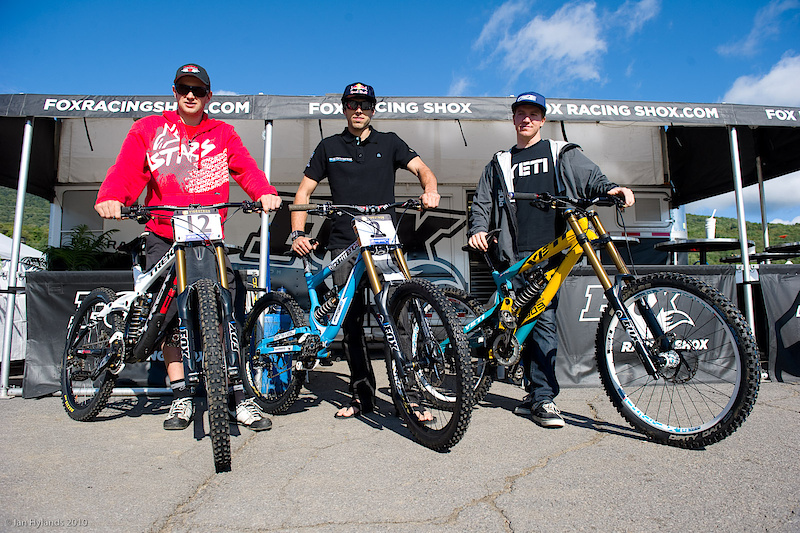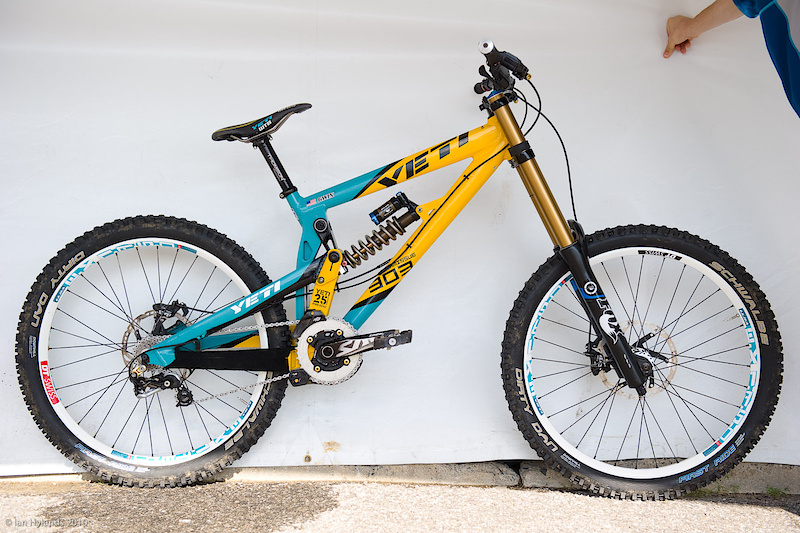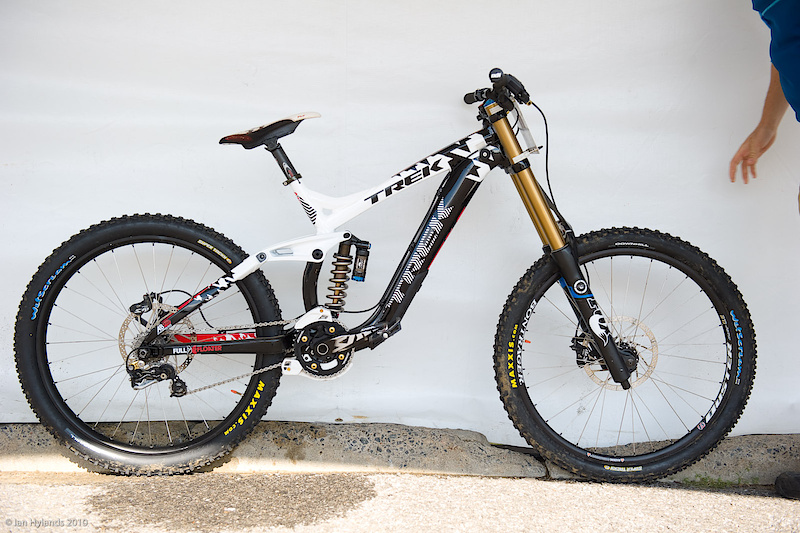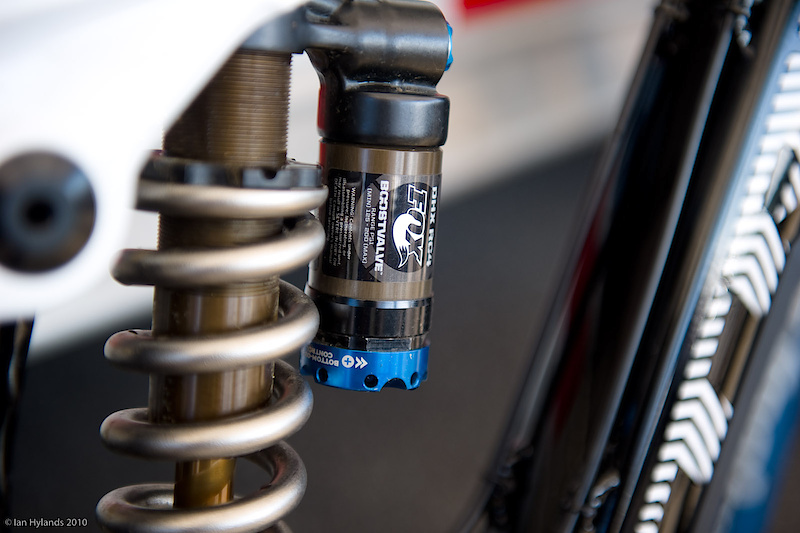Fox Riders' MSA set ups!
Everyone wants to know what the pros are running at the races, what their set ups are like from tires, to settings on their suspension. Fox Racing Shox wants you to know what their top tier DH racers are running and how it varies from regular consumers' forks and shocks. At MSA they got a few of us media darlings together with their staff members and 3 of the world's fastest racers - Aaron Gwin, Gee Atherton and Justin Leov.
Read on to learn how the pros set up their bikes at MSA,
Getting to talk with Fox's lead engineers and racers about set up was really intriguing to say the least. I was amazed to hear that the average pro runs the same tuning set up for wet or dry conditions - they may back off the High Speed compression a bit initially from race weekend to race weekend for new tracks and then slowly ramp it back up to where it was by race day as they get traveling faster and faster on the tracks.
The pros all run stiffer set ups due to the higher speeds in which they are traveling and the need to keep their bikes moving forward as efficiently as possible. But they all said that they have "play" settings for when they are not racing or holding on for dear life.
Here are set ups for Aaron Gwin, Gee Atherton and Justin Leov from their MSA race bikes. (Fox counts all of the clicks from closed. They turn the adjuster in clockwise until it stops and count clicks counterclockwise. For example compression would be 8 clicks out. They do this because the closed position on their products is always a constant. When they make a valving change counting the clicks from closed doesn’t change. When going from open there are piston and shim stack heights that alter the “open” position.):
Aaron Gwin's Yeti 303:
Gee Atherton's Commencal Supreme DH:
Justin Leov's Trek Session 88:
Please visit www.foxracingshox.com/bike to learn more about all things Fox Racing Shox related.
*All Photos by Ian Hylands
Read on to learn how the pros set up their bikes at MSA,
Getting to talk with Fox's lead engineers and racers about set up was really intriguing to say the least. I was amazed to hear that the average pro runs the same tuning set up for wet or dry conditions - they may back off the High Speed compression a bit initially from race weekend to race weekend for new tracks and then slowly ramp it back up to where it was by race day as they get traveling faster and faster on the tracks.
The pros all run stiffer set ups due to the higher speeds in which they are traveling and the need to keep their bikes moving forward as efficiently as possible. But they all said that they have "play" settings for when they are not racing or holding on for dear life.
Here are set ups for Aaron Gwin, Gee Atherton and Justin Leov from their MSA race bikes. (Fox counts all of the clicks from closed. They turn the adjuster in clockwise until it stops and count clicks counterclockwise. For example compression would be 8 clicks out. They do this because the closed position on their products is always a constant. When they make a valving change counting the clicks from closed doesn’t change. When going from open there are piston and shim stack heights that alter the “open” position.):
Bar: Sunline Bar
Stem: Sunline DM Stem
Grips: ODI Ruffian
Cranks (length and tooth size): SAINT 165mm w/40T ring
Chain Guide: e.13
Shifter: SAINT
Rear Derailleur: SAINT
Brakes (Rotor sizes): SAINT w/ 203mm Front and Back
Seat Post: Thomson Master Piece
Saddle: WTB Silverado
Wheels: DT Swiss 1750
Tires: Schwalbe Dirty Dan (rear cut down)
Tubes: Yes
Pedals: Shimano DX Clips
Cassette: Shimano 11-23 (9 speed)
Rear Shock: Fox DHX RC4
Spring Weight: 400 lbs
Low Speed: 9 clicks
High Speed: 4 clicks
Rebound: 5 clicks
Fork: Fox 40 Fit RC2 w/ Kashima Coating
Low Speed: 8 clicks
HS Speed: 14 clicks
Pre Load: Zero
Rebound: 12 clicks
Spring: Green
*Special Tuning: Custom Compression valve stack. If a consumer's valve stack is rated a 5, then Gwin's is a 9 for firmness.
Stem: Sunline DM Stem
Grips: ODI Ruffian
Cranks (length and tooth size): SAINT 165mm w/40T ring
Chain Guide: e.13
Shifter: SAINT
Rear Derailleur: SAINT
Brakes (Rotor sizes): SAINT w/ 203mm Front and Back
Seat Post: Thomson Master Piece
Saddle: WTB Silverado
Wheels: DT Swiss 1750
Tires: Schwalbe Dirty Dan (rear cut down)
Tubes: Yes
Pedals: Shimano DX Clips
Cassette: Shimano 11-23 (9 speed)
Rear Shock: Fox DHX RC4
Spring Weight: 400 lbs
Low Speed: 9 clicks
High Speed: 4 clicks
Rebound: 5 clicks
Fork: Fox 40 Fit RC2 w/ Kashima Coating
Low Speed: 8 clicks
HS Speed: 14 clicks
Pre Load: Zero
Rebound: 12 clicks
Spring: Green
*Special Tuning: Custom Compression valve stack. If a consumer's valve stack is rated a 5, then Gwin's is a 9 for firmness.
Bar: PRO Atherton Bar
Stem: PRO Atherton DM Stem
Grips: PRO Lock on grips
Cranks (length and tooth size): SAINT 165mm w/ 38T ring
Chain Guide: e.13
Shifter: Shimano XTR
Rear Derailleur: SAINT
Brakes (Rotor sizes): SAINT w/ 203mm Front and Back
Seat Post: PRO Carbon
Saddle: Proto-type
Wheels: SAINT
Tires: Cut Spikes
Tubes: Yes
Pedals: Crank Brothers Mallets
Cassette: 11-21 (9 speed)
Rear Shock: Fox DHX RC4
Spring Weight: 350 lbs
Low Speed: 9 clicks
High Speed: 7 clicks
Rebound: 5 clicks
Fork: Fox 40 Fit RC2 w/ Kashima Coating
Low Speed: 9 clicks
HS Speed: 14 clicks
Pre Load: Zero
Rebound: 12 clicks
Spring: Green
*Special Tuning: Custom Compression valve stack. If a consumer's valve stack is rated a 5, then Gee's is an 8 for firmness.
Stem: PRO Atherton DM Stem
Grips: PRO Lock on grips
Cranks (length and tooth size): SAINT 165mm w/ 38T ring
Chain Guide: e.13
Shifter: Shimano XTR
Rear Derailleur: SAINT
Brakes (Rotor sizes): SAINT w/ 203mm Front and Back
Seat Post: PRO Carbon
Saddle: Proto-type
Wheels: SAINT
Tires: Cut Spikes
Tubes: Yes
Pedals: Crank Brothers Mallets
Cassette: 11-21 (9 speed)
Rear Shock: Fox DHX RC4
Spring Weight: 350 lbs
Low Speed: 9 clicks
High Speed: 7 clicks
Rebound: 5 clicks
Fork: Fox 40 Fit RC2 w/ Kashima Coating
Low Speed: 9 clicks
HS Speed: 14 clicks
Pre Load: Zero
Rebound: 12 clicks
Spring: Green
*Special Tuning: Custom Compression valve stack. If a consumer's valve stack is rated a 5, then Gee's is an 8 for firmness.
Bar: Fun Full On
Stem: Funn DM
Grips: ODI Ruffian
Cranks (length and tooth size): SAINT 165mm w/ 38T ring
Chain Guide: e.13
Shifter: SAINT
Rear Derailleur: SAINT
Brakes (Rotor sizes): SAINT w/ 203mm Front and Back
Seat Post: SDG I-beam
Saddle: SDG I-beam
Wheels: Bontrager
Tires: Cut Spikes
Tubes: Yes
Pedals: Crank Brothers Mallets
Cassette: 11-21 (9 speed)
Rear Shock: Fox DHX RC4
Spring Weight: 450 lbs
Low Speed: 12 clicks
High Speed: 9 clicks
Rebound: 6 clicks
Fork: Fox 40 Fit RC2 w/ Kashima Coating
Low Speed: 10 clicks
HS Speed: 13 clicks
Pre Load: Zero
Rebound: 12 clicks
Spring: Green
*Special Tuning: Custom Compression valve stack. If a consumer's valve stack is rated a 5, then Justin's is an 8 for firmness.
Stem: Funn DM
Grips: ODI Ruffian
Cranks (length and tooth size): SAINT 165mm w/ 38T ring
Chain Guide: e.13
Shifter: SAINT
Rear Derailleur: SAINT
Brakes (Rotor sizes): SAINT w/ 203mm Front and Back
Seat Post: SDG I-beam
Saddle: SDG I-beam
Wheels: Bontrager
Tires: Cut Spikes
Tubes: Yes
Pedals: Crank Brothers Mallets
Cassette: 11-21 (9 speed)
Rear Shock: Fox DHX RC4
Spring Weight: 450 lbs
Low Speed: 12 clicks
High Speed: 9 clicks
Rebound: 6 clicks
Fork: Fox 40 Fit RC2 w/ Kashima Coating
Low Speed: 10 clicks
HS Speed: 13 clicks
Pre Load: Zero
Rebound: 12 clicks
Spring: Green
*Special Tuning: Custom Compression valve stack. If a consumer's valve stack is rated a 5, then Justin's is an 8 for firmness.
Please visit www.foxracingshox.com/bike to learn more about all things Fox Racing Shox related.
*All Photos by Ian Hylands
Author Info:
Must Read This Week
[UPDATED] Final Elite XC Results & Overall Standings from the Mairiporã XC World Cup 2024
42323 views
42323 views
Sign Up for the Pinkbike Newsletter - All the Biggest, Most Interesting Stories in your Inbox
PB Newsletter Signup












they also haven't mentioned how much bottom out they run on the rear shocks maybe its redundant now since the shock has two of the same adjustment?
someone please explain to me im really confused...
IFP: Internal Floating Piston. Air on one side, oil on another.
Bottom out: this is handled by the big dial at the end of the reservoir near the valve, and that's pretty much a control over air chamber size resulting in more linear or progressive feel. More progressive = harder to bottom. Though air pressure has also certain influence on B-Out. These two things chamber volume/air pressure are "relying" on each other.
These provide IFP resistance against oil pressure that has been pushed through compression valves.
Best way to understand is just to see the shock section.
and i will take a look at the shocks section.
Without these points it's hard to use the information to make comparisons with our own setups.
Please post more of these and include VPP suspension setups if possible. Great topic and information.
Getting this same info on VPP or other specific rigs would really be helpful. I had to go through 3 springs to get the right spring weight on my 951 because the leverage behavior of VPP is so different than other platforms (much higher spring rate than calculated for single pivot). It's very difficult to get guidance on this stuff from the shop or any sites on-line.
every 12-year-old thinks, he will be a professional if he tunes the bike's suspension to extra firm...
come on! first reach that level...
I MSA i saw Sam Hill take his weight off the bike, and im pretty sure that he had no more than 10% sag, maybe even 5%.
That being said, im no expert, so they might have less sag but more plushiness further into the stroke to get better pedaling, idk.
Injuries suck ....